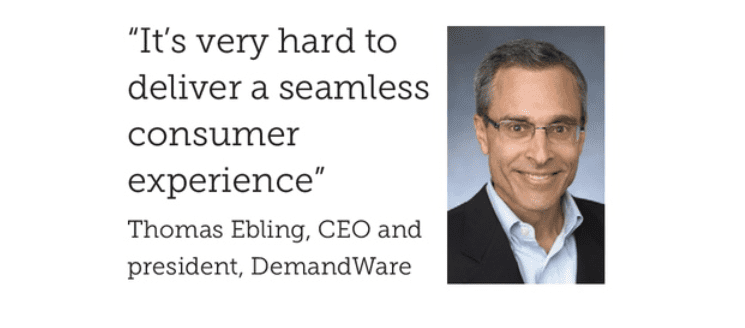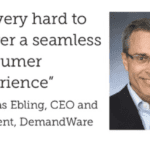Demandware CEO Thomas Ebling explains why purchasing a new point-of-sale solution is, at this moment in retail’s development, an especially crucial decision. Jonathan Wright reports…
IT WAS ONE of those deals that, outside the retail technology community, produced little comment. In January 2015, Demandware announced that it had agreed to purchase point-of-sales (PoS) solutions provider Tomax. So why was a company associated with ecommerce interested in a company selling the technology used on high streets and in shopping malls?
In part, this is a story about a fit between the companies rooted in both organisations making cloud technology central to their offerings. However, there’s another, more interesting story here too, one bound up with the way the retail industry is changing. For many years now, retailers have talked about the need to track customers across channels. It’s been a board level strategic issue but there’s been a problem: following customers as they weave their way merrily across channels is difficult to do.
This is often presented as a problem of getting customers to sign in when they enter the store. Is a store card linked to a smartphone the answer? Or getting an app and in-store beacons to talk to each other? But such approaches risk being piecemeal. They don’t tackle a bigger issue, one entified by Thomas Ebling, Demandware’s CEO and president, at a briefing held at the company’s XChange Conference in Berlin earlier this year. “A few years ago,” he said, “some of our leading customers who were thinking far ahead started saying – and it’s still true now – that you’ve really got two separate technology stacks, one for ecommerce and one for point of sale in the store. The result of having two separate technology stacks is it’s very hard to deliver a seamless consumer experience.
“Even with something as simple as buying an item online and returning in-store, customers have to go through a lot of hoops to make that work because of the different technologies, let alone the more complex things like returning something in-store and buying something in-store at the same time in the same transaction.”
A unified approach
One obvious solution is to unify the technology, to apply the same approach across different channels. Except again, this is easier said than done. PoS upgrades are expensive enough to undertake in isolation, especially for bigger retailers, let alone when also tackling, for example, the issues around company silos that inevitably arise when trying to marry systems together. To look at that another way, no multichannel retailer starting out today wants to begin with two separate technology stacks.
To illustrate what we mean, consider Apple . Since Apple was an online retailer before it ever made it to the high street, because it’s a technology company that routinely gathers rich data, and perhaps because so many of its customers are brand-sensitive devotees, the company already had an unusual amount of information about those who bought its products. When it opened its stores, it certainly didn’t create a new silo in which to hold customer information about footfall customers.
“They built the technology from the beginning to be one technology to do every consumer interaction,” noted Ebling. “Our vision was that’s where the market needed to go and that’s where we needed to go.”
No wonder. Apple’s approach has set new benchmarks for the kind of experience customers get in bricks-and-mortar stores. Instead of an internal layout that revolves around directing customers towards clunky old tills, sales assistants are better able to wander around the shop, answering questions, demonstrating items and then processing payments using handheld devices. This isn’t just about looking cool. Apple’s stores generated sales of $5,009 per square foot in the year leading up to May 2015, more than any other retailer in the US.
Big decision
It’s against this backdrop that retailers need to consider new PoS investments. While it would be an optimistic and/or determined retailer that tried to get the same return on retail space that Apple generates, this is the gold standard, and Apple and other forward-looking retailers are only going to refine their bricks-and-mortar operations in the years ahead. So are other retailers rising to the challenge? According to Ebling, they are. Demandware, he noted, already had three US customers signed up for its PoS solution. “To some extent, we wish we could move our technology even faster because the interest in the US – which is the only place we’ve started targeting this a lot because that’s our first market – well, we’ve got way more interest than we can fulfill because we want to make these first customers successful,” he said.
Ebling thinks this will be a growing market. “We expect that, due to consumer expectations, the model in the store is going to change a lot in the future and if it changes, people’s old systems are not going to meet the needs. They tend to be upgraded in very long cycles and be very inflexible, so we think there’s a terrific opportunity for us to deploy the kind of flexibility that we have in online commerce in the store.”
In June 2016, in a deal that attracted rather more attention than the 2015 acquisition,
Apple’s stores generated sales of $5,009 per square foot in the year leading up to May 2015, more than any other US retailer…
customer relationship management specialists SalesForce announced the purchase of Demandware in a deal valued at $2.8bn. This was widely reported as being down to SalesForce needing a better ecommerce offering. Demandware’s targeting of PoS business suggests that seeing the deal in terms of ecommerce alone may be to miss a small but crucial detail of the wider picture.






